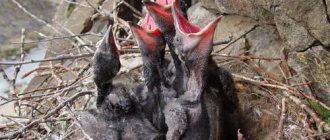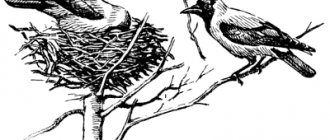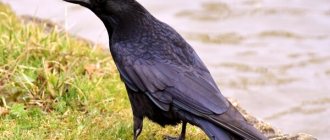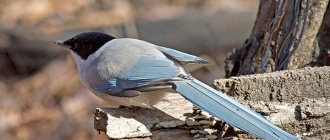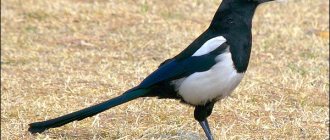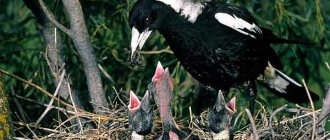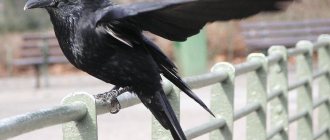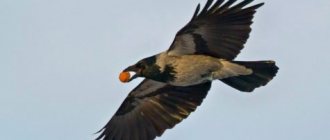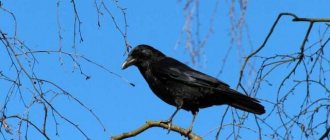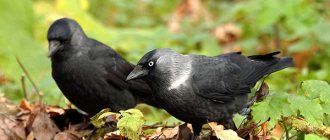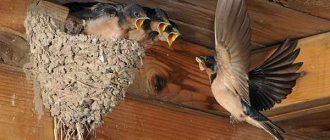Magpies, jackdaws, rooks and crows resemble each other in appearance and lifestyle. Most of them live close to us, eat scraps and find shelter where we build our homes. Every autumn, the cities of our country are filled with black birds that make loud noises, move actively and fly in flocks. In this feathered fraternity, it is difficult to determine which species a particular bird belongs to. They all resemble crows. But there is still a difference.
Origin of the species and description
Photo: Soroka
The magpie, also known as the common magpie or, as it is sometimes called the European magpie, is a fairly well-known bird from the corvid family of the passerine order. With its name, it also gave the name to the genus of magpies, which also includes some exotic species that are similar to ordinary magpies in body structure, but differ from them in bright and variegated colors. The Latin name of the species is Pica pica. The closest relatives of these birds are crows and jays.
The time of origin of magpies and their separation from other corvids is not known for certain. The earliest fossil records of corvid-like birds date back to the Middle Miocene and are about 17 million years old. They were discovered on the territory of modern France and Germany. From this we can assume that the division of the family into species occurred much later.
Video: Magpie
Now ornithologists proceed from the assumption that magpies as a species appeared in Europe, and gradually spread across Eurasia, and then in the late Pleistocene they entered the territory of modern North America through the Bering Strait. However, fossils were found in Texas that were more reminiscent of the modern European magpie than the Californian subspecies, so there was a version that the common magpie could have appeared as a species already in the Pliocene, that is, about 2-5 million years ago, but in any case not earlier this time.
Today, at least 10 subspecies of magpie are known. Distinctive features of common magpies are their long tail and black and white coloration.
Crow
Crow is a species of bird of the Raven genus from the Corvidae family.
These birds have developed intelligence. They even have their own games - for example, crows like to tease dogs (obviously for fun) or play “tag” with each other. Crows often become tame and can be trained.
The habitat of crows is mainly the territory of Eurasia.
There are several varieties of these birds. Most often in the city you can find a black crow with a characteristic bluish tint of shiny feathers. There are also hooded crows, which are very similar in feather color to magpies (which further adds to the confusion). Only their color is not black and white (not magpie), but black and gray.
Ravens are fairly large birds (the weight of an average individual is approximately 300 grams) with strong black beaks and fairly massive paws. Males differ from females only in their slightly larger sizes.
Crows are omnivores, but their favorite delicacy is carrion. The lifespan of these birds in nature is about 20 years. In captivity, surrounded by human care, crows live much longer, up to 35-40 years.
These amazing birds communicate with each other through a characteristic hoarse croak that cannot be confused with anything else. Crows usually live in flocks.
These are not migratory birds, leading a predominantly sedentary lifestyle. Only unfavorable living conditions can force them to wander.
You may also be interested: Municipal district and urban district - what are they and the differences
Appearance and features
Photo: Magpie Bird
The color of the magpie is unique, and therefore it is well recognized by many. The entire plumage is black and white. The bird's head, neck, back and chest and tail are black with a metallic, sometimes bluish tint, tint and shine, especially evident in the sun's rays. At the same time, the belly, sides and shoulders of the magpie are white. Sometimes it happens that the tips of the wings are also painted white. Because of their characteristic white coloration, magpies are often called “white-sided magpies.”
Magpies can be up to 50 cm in length, but more often about 40-45 cm. The wingspan is 50-70 cm, in some cases up to 90 cm, but this is an exception rather than commonplace. The tail is quite long, almost 25 cm, which is almost half the length of the entire bird, stepped and quite mobile. Females and males do not differ in appearance, as they have the same color and the same size.
There is still a difference, and it consists in the fact that the males are slightly heavier, but this is not visually noticeable from the outside. The average male weighs about 230 grams, while the average female weighs approximately 200 grams. The bird's head is quite small, the beak is slightly curved and very strong, which is typical for all corvids.
The paws are of medium length, but very thin, four-toed. It moves along the ground in forty leaps and bounds, and simultaneously on both legs. The tail is held up. A gait like that of crows or pigeons is not typical for magpies. In flight, the bird prefers to glide, so the magpie's flight looks heavy and undulating. It is sometimes called "diving". During its flight, the magpie spreads its wings wide and spreads its tail, so it looks very beautiful, and its shape even resembles birds of paradise.
The loud chirping of a magpie is very characteristic. Its sound is very recognizable, and therefore it is difficult to confuse it with any other bird call.
General characteristics of the crow
First of all, we will tell you what a crow looks like and what its distinctive features are.
The crow and raven (krook) belong to the same genus of birds. But these are two different types of birds.
The body length of a raven is 60-65 cm. Females reach 1300 grams in body weight, and males weigh up to 1500 grams. These are the largest representatives of the Crow genus. Their plumage is black with a green or purple metallic tint. Eye color is dark. The tail is wedge-shaped.
A striking distinctive feature is the “beard” of feathers on the throat.
The crow's dimensions are noticeably more modest. The weight of an adult is 460-730 grams. The length of its body does not exceed 50 cm. The color of the plumage varies from gray to gray-black. The tail is straight.
Another distinctive feature of the raven is that it is practically never found in the city. These birds avoid human presence and settle in the forest.
Other differences between these birds can be found in the article “The Common Raven and the Crow: Different, but Similar.”
Where does the magpie live?
Photo: Magpie animal
The habitats of magpies are mostly located in Eurasia, with the exception of its northeastern part, but there is an isolated population in Kamchatka. Magpies are found throughout Europe from Spain and Greece to the Scandinavian Peninsula. These birds are absent only from some of the islands in the Mediterranean Sea. In Asia, birds settle south of 65° north latitude, and closer to the east, the northern border of the magpie’s habitat gradually retreats south to 50° north latitude.
Birds inhabit the northern parts of Africa, very close to Europe, to a limited extent - mainly the coastal regions of Algeria, Morocco and Tunisia. In the Western Hemisphere, magpies are found only in North America, in its western regions from Alaska to California.
Typical habitats for magpies are open spaces suitable for foraging for food. But at the same time, they must be near trees or bushes so that they can build a large nest. Very rare in large forests. The Magpie can be considered a typical resident of rural areas. She loves to settle in the vicinity of meadows and fields, surrounded by bushes and forest belts. But magpies are also found in city parks and alleys, which is associated with a simpler search for food in cities in winter conditions in the form of waste and food leftovers. Sometimes birds settle along highways or railways.
Magpies never leave their homes for long. Yes, sometimes they can gather in small flocks and move from a village or field to a small town for the winter to make it easier to find food, but all this happens within one region, and the distance of movement does not exceed ten kilometers. This is too little compared to other birds that travel significant distances with the changing seasons. Therefore, magpies are sedentary birds and not migratory.
What does a magpie eat?
Photo: Magpie in the forest
In fact, the magpie is an omnivorous bird. She can eat grains and seeds in the fields, peck insects and parasites from the wool of grazing cattle or large wild animals, and willingly eat worms, caterpillars and larvae, having learned to dig them out of the ground. In agricultural areas, magpies are not liked because they spoil the harvest, for example, they peck at cucumbers, apples, and in the southern regions also watermelons and melons.
In times of famine, they do not disdain carrion and garbage in city garbage dumps. They willingly eat the contents of feeders, including bread, nuts, grains or other plant foods left there. They can easily steal bones from dogs. But usually, other things being equal, magpies still try to eat animal food.
In addition to insects, their diet includes:
- Small rodents;
- Frogs;
- Snails;
- Small lizards;
- Chicks of other birds;
- Eggs from other people's nests.
If the size of the prey turns out to be large, then the magpie eats it in parts, breaking off pieces of meat with its powerful beak and holding the rest of the meal with its paws. Birds living in bushes or open fields especially suffer from the predatory actions of magpies - partridges, larks, quails and some other birds, into whose nests magpies climb during the nesting season in order to steal eggs or eat hatched chicks.
Interesting fact: the magpie buries excess food in the ground as reserves in case of famine. At the same time, the bird’s intelligence allows it to quickly find its hiding place. Unlike magpies, neither squirrels nor thrifty small rodents can repeat this.
Brief conclusions
Here are the signs by which it is easy to distinguish such birds that are similar to each other:
- Crows, unlike rooks, are monogamous,
- The raven's step is larger than that of other relatives,
- The flight of a raven is noisier due to its impressive weight,
- Magpie is the brightest and most recognizable bird of all its brothers,
- She makes specific sounds that are not characteristic of others,
- Rooks lead a migratory lifestyle, while other birds spend the winter in their homeland.
- The beak of an adult rook is light,
- Jackdaws are the smallest birds of all those represented.
By paying attention to these characteristics, you can easily determine who is in front of you.
If the article was useful to you, share the information received with your friends on social networks and leave your comments.
Features of character and lifestyle
Photo: Magpie in flight
Magpies live in small flocks of 5-7 birds, less often alone. Group living is very beneficial for them from a safety point of view. The magpie warns of the approach of enemies or any suspicious living creatures by chirping, which other birds and even animals, such as bears, have learned to understand. That is why, when hunters appear, animals often run away only when they hear a magpie. The peculiarity of magpies is that they are paired, and form pairs for life.
Two birds always participate in the construction of nests. The nest is laid in a spherical shape with an entrance in the side and an adjacent clay tray. Clay and hard branches, along with leaves, are used to build walls and roofs, and branches are specially used for the roof. The insides of the nest are lined with straw, dry grass, roots and scraps of wool. During the breeding season, one pair can build several nests, but in the end they choose one. Abandoned nests are then inhabited by other birds, for example, owls, kestrels, and sometimes animals, for example, squirrels or martens.
Despite its sedentary lifestyle, compared to other corvids, the magpie is a very mobile and active bird. It is characterized by daily movements. She rarely stops for a long time in one place and constantly jumps from one branch to another, flies over long distances, searches bushes and trees in search of other people's nests and food. Leads a purely diurnal lifestyle.
The magpie has a good memory, and is also considered one of the most intelligent among all birds. Although she is very curious, she is also very cautious and able to avoid traps. The bird easily learns, masters new skills and quickly adapts to a changing environment. Zoologists have also discovered elaborate sequential actions and social rituals in magpies.
There are suggestions that magpies are even familiar with the expression of sadness. It is well known that these birds are partial to shiny objects, which they steal from people every now and then or pick up on the roads. It is interesting that thefts never occur openly, and before stealing an object, birds always first make sure that they are not in danger.
Interesting fact: today the magpie is the only bird that is able to recognize itself in the mirror, and not think that there is another individual in front of it.
Do you need to chew food to feed a baby crow, little jackdaw, or little magpie?
If not, infect the chick with “human” microflora, which is dangerous for birds. Most diseases of corvids are caused by microflora that are opportunistic for humans: E. coli, staphylococci, enterococci. Those. This microflora can normally live in a person’s mouth without causing disease in a healthy person, but these bacteria are dangerous for birds.
Social structure and reproduction
Photo: Magpie on a branch
Magpies are distinguished by the fact that they are often devoted to their chosen one. They choose their companion in the first year of life. For them, this is a responsible decision, because as a pair they will build a nest and feed the chicks in all subsequent years.
In spring, magpies choose a secluded place in a bush or high in a tree. If there are houses inhabited by people nearby, then magpies choose a nesting site as high as possible, fearing encroachment. Magpies begin to mate with a partner only in the second year of life.
Magpies typically lay about seven or eight eggs. Egg laying occurs in mid-April. Their eggs are light blue-green with speckles and are of medium size, up to 4 cm in length. The female incubates the eggs. For 18 days, she warms the future chicks with her warmth. The chicks are born naked and blind. Once they hatch, the parents share caregiving responsibilities equally. That is, both the female and the male take care of the chicks. They spend all their time searching for and delivering food to their offspring.
This lasts for about a month, and around day 25 the chicks begin to try to fly out of the nest. But attempts to fly independently do not mean that they will begin an independent life so quickly. They stay with their parents until the fall, and sometimes for a whole year. For a long time, they intercept food from their parents, although physically they are already quite capable of getting it themselves.
It happens that magpies' nests are destroyed by predators. In such cases, magpies can build a nest again or complete an abandoned one, and then lay eggs again. But they will do this more efficiently. Sometimes entire groups of magpies are observed laying eggs in June. Probably, for some reason, their previous spring attempt to reproduce was unsuccessful.
Where can chicks seek veterinary care if there are no ornithologists in the city?
Veterinarians specializing in the treatment of birds can provide qualified assistance to chicks. There are very few such doctors; if there are no such specialists in your city, then you can contact an avian doctor for an online consultation. For example to me. The doctor will need a video of the bird and a description of the problem. Next, the doctor will decide what tests will need to be taken and where, will advise where to take a digital x-ray and how to keep the bird under x-ray. You will need to send the resulting x-ray images by email to the selected doctor.
Natural enemies of magpies
Photo: Magpie in nature
In the wild, forty's enemies include mainly large species of birds of prey:
- Falcons;
- Owls;
- Eagle owls;
- Eagles;
- Eagles;
- Hawks;
- Eagle owls.
Magpie chicks living in tropical regions also sometimes suffer from snake attacks. In our latitudes, a squirrel, hazel dormouse or marten can climb into a bird’s nest. Moreover, if the last two animals eat chicks and eggs, then the squirrel may not even feast on the bird’s eggs or its chicks, but simply throw them out of the nest.
And this also leads to their death. Adult birds are too large for such animals. But among larger mammals, adult magpies are often attacked by wild cats. Sometimes birds become prey for foxes and in very rare cases for wolves or bears. The magpie is very cautious, and therefore is caught very rarely, and the victims are mainly sick or very old birds.
Today, man has turned from an enemy of the magpie into something neutral. Yes, sometimes nests are destroyed or magpies are exterminated as pests, but this occurs in very rare cases, and magpies are saved by ingenuity and caution. At the same time, thanks to humans, birds have the opportunity to constantly find food in landfills.
We picked up a jackdaw, crow, rook, raven, jay - how to examine the chick?
Immediately after picking up a bird, you need to contact a veterinarian specializing in the treatment of birds - an avian doctor. In urban conditions, most corvid chicks suffer from rickets (this is due to a lack of insects and small animals needed by the chicks, which parent birds cannot provide to their chicks in urban conditions), as well as from a large number of worms, trichomoniasis, and bacterial infections. and viral infections inherent in urban living conditions.
Contact your veterinarian immediately. Each day of delay affects whether the chick will have a chance of subsequent rehabilitation. If a chick has crooked paws or a bent toe, if it constantly sleeps, or cannot stand on its paws on its own, these are signs of disease. We must act quickly. If a chick's wings are drooping or dangling, this may be a sign of extreme weakness, exhaustion, or a broken wing. Such birds should be examined by a doctor as soon as possible, and x-rays must be taken.
The selected chick, even if it looks healthy, will need a course of anthelmintics and medications against ticks, pereaters and other ectoparasites.
